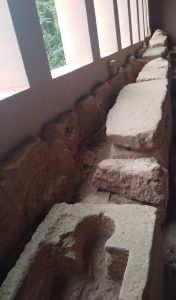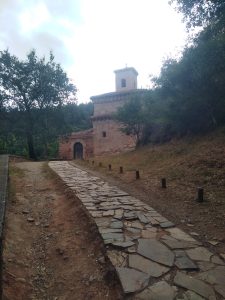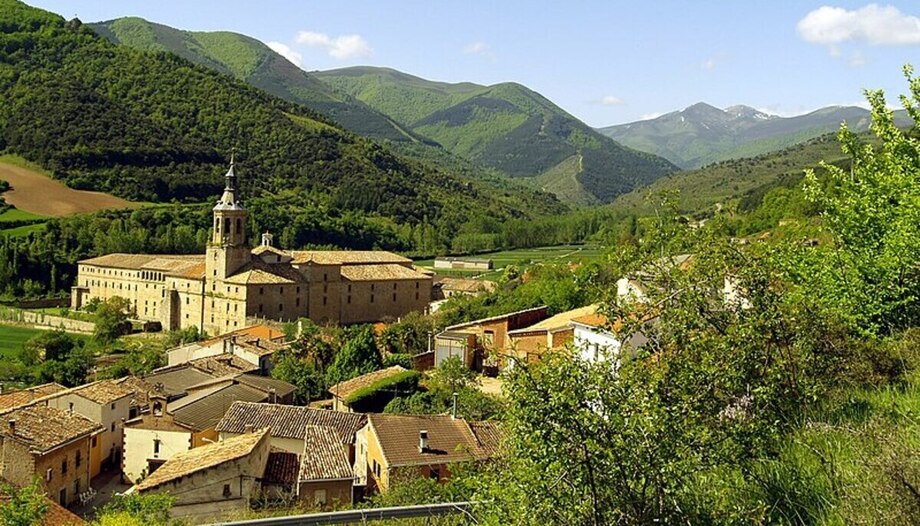San Millán was born in Berceo (now a town in La Rioja) in 473 AD. At that time, in the Iberian Peninsula, already Christianized, the Hispano-Romans and the newly arrived Visigoths coexisted. At that time, Euric reigned, although the long life of San Millán spanned 10 reigns, since he lived 101 years, from 473 to 574.
Shepherd in Berceo
From a hispanoroman and peasant family, he was a shepherd until he was 20 years old. From then on, he decided to embrace religious life and left Berceo to study with the anchorite Saint Felices de Bilibio. Subsequently, he became a hermit and returned to his native region, retiring to some caves that are now located in the town of San Millán de la Cogolla (a town that did not exist at that time and that was formed because many people went to settle there because of the saint).
Saint Millán, hermit
With a reputation for holiness due to his miracles, he soon had followers who formed a community in the nearby caves, both men and women, for example St. Citonato, St. Sophronius, St. Oria (Gonzalo de Berceo wrote the poem "Life of St. Oria") and St. Potamia, who today gives her name to one of the streets of the village.

Due to the increase of followers, a Visigothic church was built next to the caves, which was later enlarged during the Mozarabic period. This church was polychrome, but in the year 1002 Almanzor set fire to it and today only some small remains of that decoration are preserved. From the original church, you can still see a Visigothic altar from the 6th century, the oldest one preserved in the Peninsula and in most of the West.
First traces of Spanish
The current Monastery of Suso, in San Millán de la Cogolla, is built in the caves where Saint Millán lived. Inhabited by highly educated monks, the famous Glosas Emilianenses were written there, the first written testimony of the Spanish language, clarifications to the Latin text that an anonymous monk copyist wrote in Romance on the right margin of the codex. Some Basque words also appear in these glosses.
When he died in 574, Saint Millán was buried in Suso, and his remains remained there until 1053, when King García decided to transfer him to the recently founded Santa María La Real de Nájera. However, according to tradition, the oxen transporting the funeral cart collapsed when they reached the valley, and there was no way to move them forward. This was interpreted by the king as a sign that the body of the saint should not leave the valley, and the Monastery of Yuso was built, where the remains of San Millán are preserved to this day. Both monasteries have been declared World Heritage Site.
Due to the transfer, a commemorative cenotaph of black alabaster was made in the Monastery of Suso in the 12th century, in which several figures are represented, among them St. Braulio, bishop of Zaragoza and first biographer of San Millán.
Gonzalo de Berceo
The Monastery of Suso became an important cultural center. In the 12th century, a boy named Gonzalo, born, like St. Millán, in Berceo, went there to be educated. This would be Gonzalo de Berceo, the first poet of known name who wrote his works in Romance instead of Latin. This is why this place is known as the "cradle" of the Spanish language.
In Suso also rest the remains (except for the heads) of the Seven Infantes de Lara, along with those of their ayo, Don Nuño.
The so-called "Cueva de Cuaresma" (Lenten Cave), where Saint Millán used to retire during Lent to fast and do penance, is also preserved. In the cave you can also see the tombs of noblemen who wanted to be buried near the saint. In another area of the small monastery are kept the bones of pilgrims of yesteryear that have been found in the valley.

Suso and Yuso
Today the Monastery of Suso does not house monks or hermits: the small building has remained on the top of the mountain as an architectural, historical, cultural and religious relic. However, in the monastery of Yuso still lives a community of Augustinian monks who preserve the religious cult of the place.








